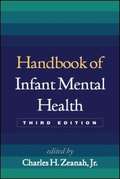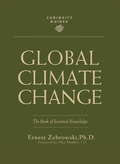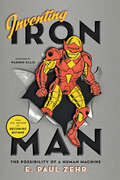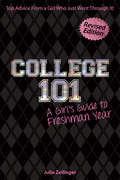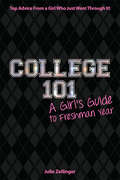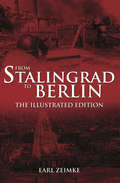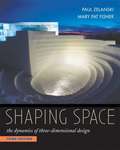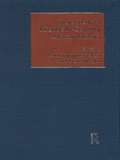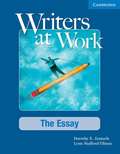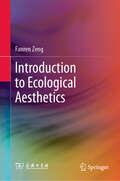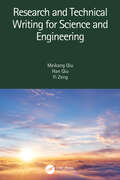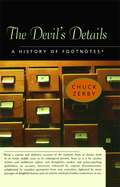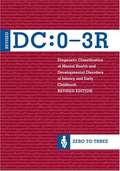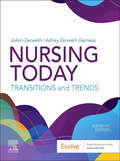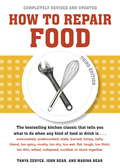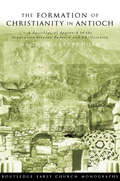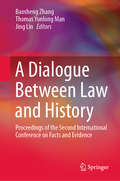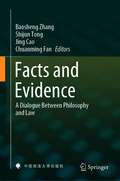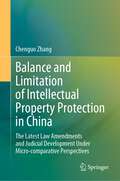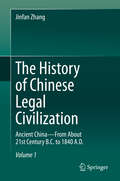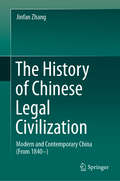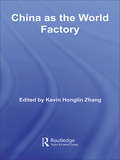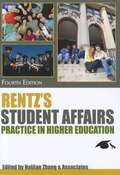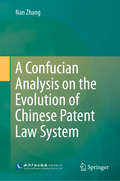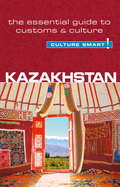- Table View
- List View
Handbook of Infant Mental Health
by Charles H. ZeanahWidely regarded as the standard reference in the field, this state-of-the-art Handbook offers a comprehensive analysis of developmental, clinical, and social aspects of mental health from birth to the preschool years. Leading authorities explore models of development; biological, family, and sociocultural risk and protective factors; and frequently encountered disorders and disabilities. Evidence-based approaches to assessment and treatment are presented, with an emphasis on ways to support strong parent-child relationships. The volume reviews the well-documented benefits of early intervention and prevention and describes applications in mental health, primary care, childcare, and child welfare settings. The chapter on psychopharmacology has been updated for the paperback edition.
Curiosity Guides: Global Climate Change
by Ernest Zebrowski"Climate change? Global warming?"... We've probably all heard these words over and over again, from media reporters, from elected officials, and even from friends and co-workers. Scientists argue about what they mean for our future.What is the truth? How can we decipher exactly what really are the effects of environmental damage? Where can we go to get dependable, clearly-written information so we can join in the conversation and take the right action?THE CURIOSITY GUIDE TO GLOBAL WARMING fills that need, with a scientifically accurate introduction to perhaps the most important issue of our time. It unravels the mysteries of nature and settles any issue of "reasonable doubt" about the reality of global climate change.Dr. Ernest Zebrowski, a prominent scientist and educator examines everything from melting glaciers and disappearing snow covers to increased levels of carbon dioxide in our atmosphere; patterns of climate change through the centuries, and the potentially disastrous effects (including rising seas, more violent storms, and alterations in agricultural productivity) of environmental damage.If you need to understand what's in the news, in print and on line about this subject, this is the one book to read.
Inventing Iron Man: The Possibility of a Human Machine
by E. Paul ZehrTony Stark has been battling bad guys and protecting innocent civilians since he first donned his mechanized armor in the 1963 debut of Iron Man in Marvel Comics. Over the years, Stark’s suit has allowed him to smash through walls, fly through the air like a human jet, control a bewildering array of weaponry by thought alone, and perform an uncountable number of other fantastic feats. The man who showed us all what it would take to become Batman probes whether science—and humankind—is up to the task of inventing a real-life Iron Man.E. Paul Zehr physically deconstructs Iron Man to find out how we could use modern-day technology to create a suit of armor similar to the one Stark made. Applying scientific principles and an incredibly creative mind to the question, Zehr looks at how Iron Man’s suit allows Stark to become a superhero. He discusses the mind-boggling and body-straining feats Iron Man performed to defeat villains like Crimson Dynamo, Iron Monger, and Whiplash and how such acts would play out in the real world. Zehr finds that science is nearing the point where a suit like Iron Man’s could be made. But superherodom is not just about technology. Zehr also discusses our own physical limitations and asks whether an extremely well-conditioned person could use Iron Man’s armor and do what he does.A scientifically sound look at brain-machine interfaces and the outer limits where neuroscience and neural plasticity meet, Inventing Iron Man is a fun comparison between comic book science fiction and modern science. If you’ve ever wondered whether you have what it takes to be the ultimate human-machine hero, then this book is for you.
College 101: A Girl's Guide to Freshman Year
by Julie ZeilingerCollege 101: A Girl's Guide to Freshman Year is a comprehensive and authentic guide for girls to everything college. Unlike other college guides, College 101 is written from the honest, humorous, and relatable first-person perspective of a young woman who recently experienced her freshman year, while also offering the advice of experts and unique experiences of other college-aged women. This dynamic guide shows girls what to really expect from their first year of college, including pro tips and common pitfalls to avoid. From managing academics and navigating frat culture on campus, to avoiding debt and getting enough sleep, this book answers all girls' questions about university life, including those they didn't even know they had! Presented in a dynamic and varied format, College 101 imparts seriously valuable information and secrets about the freshman year that every girl needs to make sure she survives (and actually enjoys) her first college experience.
College 101
by Julie ZeilingerCollege 101: A Girl's Guide to Freshman Year is a comprehensive and authentic guide for girls to everything related to the college process. Unlike other college guides, College 101 is written from the honest, humorous, and relatable first-person perspective of a young woman who recently experienced the process, while also offering the advice of experts and unique experiences of other college-aged women. This guide shows girls what to really expect from the college planning process as well as their first year of college, including pro tips and common pitfalls to avoid. From test-taking tips, to finding the right college for you, to how to make the most of your freshman year, this book answers all young women's questions, including those they didn't even know they had! Presented in a dynamic and varied format, College 101 imparts seriously valuable information and secrets about the process in an extemporaneous and entertaining way.
From Stalingrad to Berlin: The Illustrated Edition
by Earl ZeimkeWith scarcely an interlude, the German-Soviet conflict in World War II lasted for 3 years, 10 months, and 16 days. The conflict seesawed across eastern and central Europe between the Elbe and the Volga, the Alps, and the Caucasus. The total number of troops continuously engaged averaged between 8 and 9 million, and the losses were appalling. Wehrmacht losses numbered between 3 and 3.5 million. Deaths on the Soviet side reached more than 12 million, about 47 percent of the grand total of soldiers of all nations killed in World War II. The war and the occupation cost theSoviet Union some 7 million civilians and Germany about 1.5 million. The losses, civilian and military, of Finland, the Baltic States, and eastern and southeastern European countries added millions more.The great struggle completely unhinged the traditional European balance of power. The war consolidated the Soviet regime in Russia, and enabled it to impose the Communist system on its neighbours, Finland excepted, and on the Soviet occupation zone in Germany. The victory made the Soviet Union the second-ranking world power.This book follows the conflict from Stalingrad to Berlin. Topics include strategy and tactics, partisan and psychological warfare, coalition warfare, and manpower and production problems faced by both countries, but by the Germans in particular.With a new introduction by Emmy AwardTM winning historian Bob Carruthers and numerous rare illustrations this powerful book makes for a welcome addition to any Second World War library.
Shaping Space The Dynamics of Three-Dimensional Design 3rd Edition
by Paul Zelanski Mary Pat FisherThis book offers an engaging, in-depth exploration of the aesthetic and practical considerations of working three-dimensionally. It also includes new and expanded coverage of kinetic art, ephemeral and conceptual work, and works incorporating video and sound.
Encyclopedia of Twentieth-Century African History
by Paul Tiyambe Zeleza Dickson EyohWith nearly two hundred and fifty individually signed entries, the Encyclopedia of Twentieth-Century African History explores the ways in which the peoples of Africa and their politics, states, societies, economies, environments, cultures and arts were transformed during the course of that Janus-faced century. Overseen by a diverse and distinguished international team of consultant editors, the Encyclopedia provides a thorough examination of the global and local forces that shaped the changes that the continent underwent. Combining essential factual description with evaluation and analysis, the entries tease out patterns from across the continent as a whole, as well as within particular regions and countries: it is the first work of its kind to present such a comprehensive overview of twentieth-century African history. With full indexes and a thematic entry list, together with ample cross-referencing and suggestions for further reading, the Encyclopedia will be welcomed as an essential work of reference by both scholar and student of twentieth-century African history.Choice Outstanding Academic Title 2004
Writers at Work: The Essay
by Dorothy E. Zemach Lynn Stafford-YilmazThe Writers at Work series takes beginning to high intermediate-level writing students through a process approach to writing. The series is intended primarily for adults whose first language is not English, but it may also prove effective for younger writers or for native speakers of English who are developing their competence as independent writers in English.
Introduction to Ecological Aesthetics
by Fanren ZengThis book explores in detail the issues of ecological civilization development, ecological philosophy, ecological criticism, environmental aesthetics, and the ecological wisdom of traditional Chinese culture related to ecological aesthetics. Drawing on Western philosophy and aesthetics, it proposes and demonstrates a unique aesthetic view of ecological ontology in the field of aesthetics under the direct influence of Marxism, which is based on the modern economic, social cultural development and the modern values of traditional Chinese culture.This book embodies the innovative interpretation of Chinese traditional culture in the Chinese academic community. The author discusses the philosophical and cultural resources that can be used for reference in Chinese and Western cultural tradition, focusing on traditional Chinese Confucianism, Taoism, Buddhism and painting art, Western modern ecological philosophy, Heidegger's ontology ecological aesthetics, and British and American environmental aesthetics.In short, the book comprehensively discusses the author's concept of ecological ontology aesthetics as an integration and unification of ontology aesthetics and ecological aesthetics. This generalized ecological aesthetics explores the relationship between humans and nature, society and itself, guided by the brand-new ecological worldview in the post-modern context. It also changes the non-beauty state of human existence and establishes an aesthetic existence state that conforms to ecological laws.
Research and Technical Writing for Science and Engineering
by Yi Zeng Meikang Qiu Han QiuEngineering and science research can be difficult for beginners because scientific research is fraught with constraints and disciplines. Research and Technical Writing for Science and Engineering breakdowns the entire process of conducting engineering and scientific research. This book covers those fascinating guidelines and topics on conducting research, as well as how to better interact with your advisor. Key Features: advice on conducting a literature review, conducting experiments, and writing a good paper summarizing your findings. provides a tutorial on how to increase the impact of research and how to manage research resources. By reflecting on the cases discussed in this book, readers will be able to identify specific situations or dilemmas in their own lives, as the authors provide comprehensive suggestions based on their own experiences.
The Devil's Details
by Chuck ZerbyFootnotes have not had it easy. Their dominance of eighteenth- and nineteenth- century literature and scholarship was both hard-won -- following many years of struggle -- and doomed, as it led to belittlement in the twentieth century. InThe Devil's Details,Chuck Zerby playfully explores footnotes' long and illustrious history and makes a clarion call to save them from the new world of the Internet and hypertext. In a story that boasts a marvelous plot and a rogues' gallery of players, Zerby examines traditional footnotes and their less-buttoned-down incarnations, as when used by pornographers. Yes,The Devil's Detailsis full of surprises: Zerby hunts down the first bona fide fully functioning footnote; unearths a multivolume history of Northumberland County, England, that uses one volume for a single footnote; and uncovers a murder plot. He even explains why footnotes are like blind dates. Carefully researched and highly opinionated,The Devil's Detailsaffirms that delight in reading can come from unexpected places.
Diagnostic Classification of Mental Health and Developmental Disorders of Infancy and Early Childhood (Revised)
by Zero To Three StaffZERO TO THREE'S Diagnostic Classification of Mental Health and Developmental Disorders of Infancy and Early Childhood (DC:0-3), published in 1994, was designed to address the need for a systematic, developmentally based approach to the classification of mental health and developmental difficulties in the first 4 years of life.
Nursing Today
by JoAnn Zerwekh Ashley Zerwekh GarneauMake a smooth transition from nursing school into the practice setting with Nursing Today, 11th Edition! <p><p>With this book, you will gain a solid understanding of the issues and trends that affect the nursing profession. Not only will you graduate with patient care skills, but you will advance your career with insights into writing a resume, interviewing, finding a job, and obtaining specialty certifications. This edition takes a deeper look into topics such as workplace bullying, conflict management, cultural and spiritual awareness, and the new question types found on the Next Generation NCLEX® examination. Written by well-known nursing educators JoAnn Zerwekh and Ashley Zerwekh Garneau, this easy-to-read text prepares you for success on the NCLEX-RN® exam and in professional nursing practice. <p><p> Thorough coverage prepares you for a professional career with an introduction to historical and present-day nursing as well as legal, ethical, political, and workplace issues. Learning objectives, humorous cartoons, and a pithy quote introduce the content in each chapter. <p><p>Critical Thinking boxes ask you to apply your knowledge to the practice setting. Coverage of QSEN competencies addresses effective communication, team building, evidence-based practice, patient safety, and quality assurance. <p><p>Tips for transitioning into the workplace are included in chapters such as NCLEX-RN® Exam and the New Graduate, Employment Considerations: Opportunities, Resumes, and Interviewing; and Mentorship, Preceptorship, and Nurse Residency Programs. <p><p>Career advancement tools include time management, communication and delegation, how to write an effective resume, interviewing tips, guidelines for using social media, attaining certification in a nursing specialty, and self-care strategies. <p><p>Evidence-Based Practice boxes summarize practice Issues, implications for nursing practice, and the references for the evidence. <p><p>Research for Best Practice boxes highlight the research evidence that supports clinical practice.
How to Repair Food
by Tanya Zeryck John Bear Marina BearTHE BEST-LAID PLANS OFTEN GO AWRY ... especially in the kitchen. When you're faced with one of those inevitable cooking calamities--be it a sinking souffle, salty soup, or stuck-together pasta--How to Repair Food has the answers and advice you need to get your meal back on track. First published in 1970 and now with more than 100,000 copies in print, this kitchen classic has been completely revised and updated to serve a new generation of home cooks. NEW TO THE THIRD EDITION: " Hints on lowering fat and sodium. " Ways to integrate wholesome and organic ingredients. " Tips for reducing kitchen waste. " Ideas for coping with holiday and other special-occasion dinner debacles. Filled with witty, accessible, and often ingenious solutions to mishaps that befall even the best of cooks, the alphabetical listings (from Abalone to Zucchini) are designed to rescue any dish from the brink of disaster.
The Formation of Christianity in Antioch: A Social-Scientific Approach to the Separation between Judaism and Christianity
by Magnus ZetterholmMagnus Zetterholm uses theoretical insights from the social sciences to deal with the complex issues raised by the parting of Judaism and Christianity, and the accompanying rise of Christian anti-Semitism in ancient Antioch. Unlike previous attempts to solve this problem have focused mainly on ideology, Zetterholm's excellent study emphasizes the interplay between sociological and ideological elements. For students of religious studies, classical studies, history and social science, this will give leverage and knowledge in the pursuit of their course studies.
A Dialogue Between Law and History: Proceedings of the Second International Conference on Facts and Evidence
by Baosheng Zhang Thomas Yunlong Man Jing LinThis book builds on the success of the First International Conference on Facts and Evidence: A Dialogue between Law and Philosophy (Shanghai, China, May 2016), which was co-hosted by the Collaborative Innovation Center of Judicial Civilization (CICJC) and East China Normal University. The Second International Conference on Facts and Evidence: A Dialogue between Law and History was jointly organized by the CICJC, the Institute of Evidence Law and Forensic Science (ELFS) at China University of Political Science and Law (CUPL), and Peking University School of Transnational Law (STL) in Shenzhen, China, on November 16–17, 2019. Historians, legal scholars and legal practitioners share the same interest in ascertaining the “truth” in their respective professional endeavors. It is generally recognized that any historical study without truthful narration of historical events is fiction and that any judicial trial without accurate fact-finding is a miscarriage of justice. In both historical research and the judicial process, practitioners are invariably called upon, before making any arguments, to prove the underlying facts using evidence, regardless of how the concept is defined or employed in different academic or practical contexts. Thus, historians and legal professionals have respectively developed theories and methodological tools to inform and explain the process of gathering evidentiary proof. When lawyers and judges reconsider the facts of cases, “questions of law” are actually a subset of “questions of fact,” and thus, the legal interpretation process also involves questions of “historical fact.” The book brings together more than twenty leading history and legal scholars from around the world to explore a range of issues concerning the role of facts as evidence in both disciplines. As such, the book is of enduring value to historians, legal scholars and everyone interested in truth-seeking.
Facts and Evidence: A Dialogue Between Philosophy and Law
by Baosheng Zhang Shijun Tong Jing Cao Chuanming FanThis book presents an in-depth discussion on two concepts from the field of philosophy and law, in order to improve our understanding of the relation between “fact” and “evidence” in judicial process. Since fact-finding is a difficult task for judges, proof by evidence has been devised to help them access the truth. However, in the process of judicial fact-finding, there is always a gap between fact and truth. This book covers a wide range of topics, from reflections on the concept of “fact,” “evidence” and “fact-finding” in the field of philosophy and law to individual case studies. As such it is a useful reference resource on the continuing research on the judicial proof process for students and scholars.
Balance and Limitation of Intellectual Property Protection in China: The Latest Law Amendments and Judicial Development Under Micro-comparative Perspectives
by Chenguo ZhangThe book focuses the openness of Chinese copyright law and patent law, namely the right limitation and exception rules (as the IP-internal balancing mechanism) and the right enforcement and protection (as the IP-external balancing mechanism). It examines the highlights of the 3rd and 4th amendments to the Chinese copyright law, patent law and the trademark law, addressing the most debated questions during these amendments. This book also takes a comparative approach to study the legislations and case laws in the USA, EU and China. The comparison covers the legislation, case decisions, which could offer useful clues for legislators to revise the current law, for judges to decide the cases about relevant topics and lay down their market plans. Moreover, this study also provides several recommendations for the right holders who are currently operating or planning to operate in China, regarding the de facto protection levels of their IP rights, the risks of right infringement and litigation costs as well as the trend of the goalsetting in their intellectual property strategy.
The History of Chinese Legal Civilization: Ancient China—From About 21st Century B.C. to 1840 A.D.
by Jinfan ZhangThis book, based on the theory of Marxism-Leninism, aims to study the essence, content and features of various legal systems in China in different historical periods, as well as the rules of the development of Chinese legal system. It effectively combines classic and historical analysis to probe the historical facts and elaborate the historical role of the legal system, revealing both the general and the specific rules of the development of the Chinese legal system on the basis of the existing relevant researches. The subject matter is of abundant theoretical and practical significance, as it enriches Marxist legal studies, deepens the readers’ understanding of Chinese legal civilization and offers guiding principles for the creation of socialist legal systems with Chinese characteristics. The chapters are structured chronologically, ranging from the Xia and Shang Dynasties, the Western Zhou Dynasty, the Spring and Autumn Period, the Han Dynasty, the South and North Dynasties, the Sui and Tang Dynasties, the Song Dynasty to the Ming and Qing Dynasties when Chinese legal system took on its final form. The chapters are compiled according to legislation, administrative law, criminal law and judicial system. Besides, the Chinese legal civilization after the Revolution of 1911 led by Sun Yat-sen is also addressed.
The History of Chinese Legal Civilization: Modern and Contemporary China (From 1840–)
by Jinfan ZhangThis book, based on the theory of Marxism-Leninism, aims to study the essence, content and features of various legal systems in China in different historical periods, as well as the rules of the development of Chinese legal systems. It effectively combines classic analysis and historical analysis to probe historical facts and elaborate the historical role of the legal system, revealing both the general and the specific rules of the development of China s legal system on the basis of the existing relevant research. The subject matter is of abundant theoretical and practical significance, as it enriches Marxist legal studies, deepens readers’ understanding of China s legal civilization and offers guiding principles for the creation of socialist legal systems with Chinese characteristics. It discusses the trends in thinking on the reconstruction of the legal system; changing laws; western legal culture; the legal system in the period of westernization, constitution and reform; preparation for constitutionalism; modification of the law during the late Qing Dynasty; criminal, civil and commercial legislation; and judicial reforms in the modern era as well as the various ups and downs and cases of malconduct after the founding of the People’s Republic of China.
China as the World Factory (Routledge Studies in the Growth Economies of Asia)
by Kevin Honglin ZhangFew countries have integrated into the world economy as fast – or as dramatically – as China has since 1978. The world’s most populous country is emerging as a world workshop and export machine: a visit to a department store in any country will unearth a plethora of goods manufactured in the People’s Republic. China is now the world’s fourth largest exporting nation. In this important book, Kevin Zhang brings together an international team of contributors to analyze this development process. Taking a thematic approach, the book covers: * manufacturing exports and the world workshop* foreign capital and china’s industrial development* challenges from the WTO and openness. This topical analysis will be an excellent resource for postgraduate students and researchers in the fields of Asian and Chinese studies, export studies, and economics.
Rentz's Student Affairs Practice in Higher Education
by Naijian Zhang AssociatesThe mission of this new fourth edition is to provide the reader with a solid foundation in the historical and philosophical perspectives of college student affairs development; assist the reader in understanding the major concepts and purpose of student affairs' practice, methods, and program models; enable the reader to conceptualize the theme, or the fundamental framework of student affairs administration, its roles and functions in higher education; start the new professional on the journey toward skilled student affairs practice; and facilitate the reader's comprehension of the trends and issues of each respective division of student affairs in higher education. <P> Student affairs administrators will find the 14 chapters in the book, six of which are completely rewritten, very helpful in furthering their understanding of major functions in the field. The first two chapters provide the philosophical and historical tools to clarify assumptions, values, and concerns. The enrollment management chapters on admissions, financial aid, academic advising, and orientation interweave conceptually into one package loosely constructed at some institutions and tightly constructed at others. Residence life, orientation, judicial affairs, career services, student activities, financial aid, and multicultural affairs provide an interesting, united focus on learning and living skills. Chapters on counseling, career services, and health services focus on an integrated, wellness orientation to life. The final chapter examines social justice, student learning, and professionalism. <P> This outstanding text has been designed for both master's and doctoral-level students completing graduate courses in the areas of college student personnel, student affairs, student development, higher education administration, and student affairs counseling. The book is also designed to assist practitioners who may not have sufficient background knowledge in these fields and student affairs professionals who may use the book for continuing professional development.
A Confucian Analysis on the Evolution of Chinese Patent Law System
by Nan ZhangThis book comprehensively discusses the main features of the Chinese patent law system, which not only legally ‘transplants’ international treaties into the Chinese context, but also maintains China’s legal culture and promotes domestic economic growth. This is the basis for encouraging creativity and improving patent law protection in China. The book approaches the evolution of the Chinese patent system through the ancient Chinese philosopher Confucius’s classic principle, offering readers a fresh new way to understand and analyze Chinese patent law reforms, while also outlining how Confucian insights could be used to improve the enforcement of patent law and overall intellectual property protection awareness in China. It examines ancient Chinese innovation history, explores intellectual property from a Confucian perspective, and discusses the roots of Chinese patent law, as well as the past three amendments and the trends in the ongoing fourth amendment. In addition to helping readers grasp the mentality behind the Chinese approach to patent law and patent protection, the book provides an alternative research methodology and philosophical approach by demonstrating Confucian analysis, which provides a more dynamic way to justify intellectual property in the academic world. Lastly, it suggests future strategies for local industries in the legal, cultural and sociological sectors in China, which provide benefits for domestic and overseas patent holders alike. The book offers a valuable asset for graduate students and researchers on China and intellectual property law, as well as general readers interested in Asian culture and the philosophy of law.
Kazakhstan - Culture Smart!
by Dina ZhansagimovaKazakhstan, one of the largest countries on earth, was long hidden from the rest of the world behind the Iron Curtain, and continued to remain unnoticed among the "stans" of Central Asia that gained independence from the Soviet Union in the early 1990s. Now, twenty years later, it has emerged as a modern state with far-reaching ambitions. It has developed rapidly over the last decade, raising a brand-new capital in the middle of its vast, empty grasslands, and stepping up to take the leading position in the region. Blessed with great reserves of oil, gas, and mineral resources, it is politically and economically stable, and the richest country in Central Asia. The seemingly endless expanse of the Kazakh Steppe takes visitors by surprise. In the east and southeast the terrain eventually changes to picturesque highlands and mountains, providing natural habitats for a number of rare animal and bird species. Once home to ancient civilizations, this immense land has yielded a wealth of archaeological artefacts. The modern Kazakh people emerged from the rise and fall of a succession of medieval Turkic states before being absorbed into the Russian Empire. They were pastoral nomads, self-sufficient, free, and famously adaptable. Their openness and generosity of spirit have survived against all the odds of a grim history. Today Kazakhstan is open for business, and receptive again to outside cultural influences. Culture Smart! Kazakhstan introduces Western readers to this complex, unknown people. It guides you through their traditions, customs, and social values. It describes how they behave at work, at home, at leisure, and on the street, and what they eat and drink. There are vital tips on communicating, and invaluable insights into Kazakhstan's dynamic business culture and economy.
